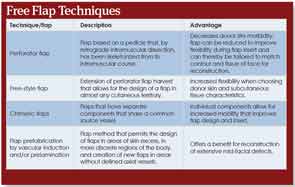According to Mark K. Wax, MD, director of the microvascular fellowship program at the Oregon Health and Science University in Portland, free flaps were initially used rarely because of their technical difficulty and the need for surgical expertise. As technology and surgical expertise have improved, he said, the success rate has risen to greater than 96 percent. Since the 1980s, he said, the failure rate has dropped from about 30 percent to between 1 and 3 percent at large centers.
Explore This Issue
September 2013Downsides and Limitations of Free Flaps
Despite the reduction in failure rates over the years, Dr. Alam emphasized the fact that facial reconstruction with free flaps is a procedure with a defined failure rate. “If a failure occurs, a revision needs to be done with a long hospitalization associated with it,” he said.
He also said that there are limitations to what can be done with free flaps, citing the difficulty of using them to reconstruct complex neuromuscular defects like total glossectomies.
For Terry Tsue, MD, physician-in-chief at the University of Kansas Cancer Center and the Douglas A. Girod, MD, endowed professor of head and neck surgical oncology at the University of Kansas School of Medicine in Kansas City, a potential downside of the procedure is the effect the procedure has on the part of the body from which the tissue is taken to use for the autogenous transplant. “When you take tissue from one part of the body that is not giving a person a problem to repair the head and neck, there is always the potential for influencing the function of the arm, leg or back from which you took the tissue,” he said. However, he said that the head and neck area is such an important part of the body in terms of hygiene, personal image and aerodigestive function that the potential effect on other parts of the body is worth the sacrifice.
The biggest limitation of using free flaps is the expertise of the surgeon and the microvascular peri-operative care team, he said, emphasizing the importance of developing the necessary skill and knowledge set to perform the procedure well.
The importance of surgical expertise in overcoming the limitations of the procedure was also cited by Dr. Alam, who speculated that the reduction in failure rates was probably due to increased surgical experience. He likened it to thyroidectomy, which carried a high mortality rate and complication rate when it was initially used in the 1920s but has been considered a routine procedure since the 1980s.

Leave a Reply